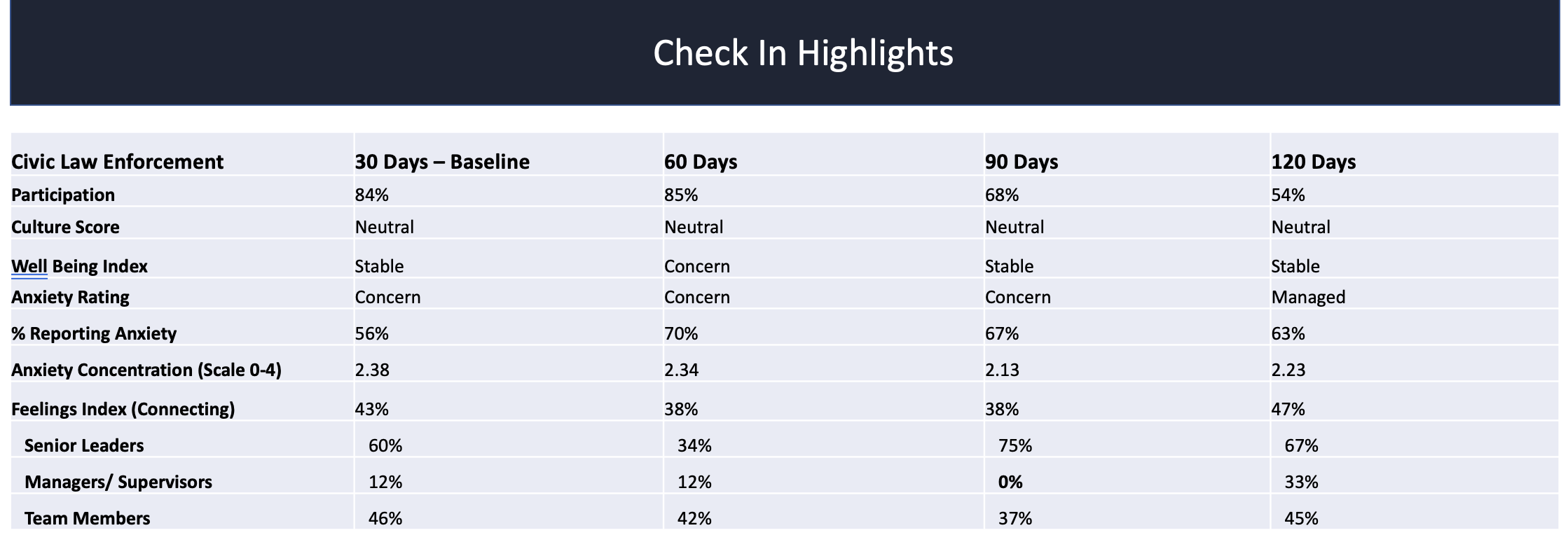Case Study Overview
Slowing Down Versus Going Fast to Improve Culture, Communication and Operational Efficiencies
Read Time: 3 minutes
Client: Civic Law Enforcement Agency
Product: Culture 5 – 4 Check-Ins, 5 Questions, 120 days
Anxiety Rating: Managed
Staff Connecting: 46% Connecting
Value to Leadership
- Positive Environment: More dialogue and laughter in leadership meetings vs pre-culture work
- People felt heard
- Leaders & Managers appreciate the value of feedback and sharing information with all
The executive coach working with leadership continued to reiterate the benefits of:
- Slowing down, pausing and stepping back to focus on operational efficiencies
- Having hard conversations and addressing accountability
- Giving leaders space to show up and celebrate positive behaviors and improvements
Leadership Profile
- This is a small civic department that deals with ‘big city crime’ issues; the department is frequently short-staffed, not enough people share the workload
- Civil law enforcement work is by nature transactional, which influences the organization’s culture; there is an emphasis on transactions versus behavioral change
- Law enforcement culture tends to be very straightforward/ numerical; conducting nebulous culture work and addressing anxiety is ‘considered ‘fluffy,’ not perceived as a concrete, deliverable ROI metric
- Leadership, managers and staff struggled to lean into difficult conversations to address the relational issues that contribute to anxiety, especially in group/ team settings
Outcomes
- Participation declined over the 120 days period due to a lack of belief that the Check In was improving the department’s culture
- Managers were consistently the least connected group across the organization (0-33%); they struggled to acknowledge their department results were “healthier” than perceived
- The relationship between management and senior leaders was a consistent bottleneck to improving communication and connecting
- Completing larger projects that required more across-department collaboration than the typical day-to-day work had a significantly positive impact on
culture scores
Requested Leadership Behaviors Expressed:
30 days: Help Balance the Load/ Avoid Burnout
60 days: Help Balance the Load/ Avoid Burnout
90 days: Improve Operations & Efficiency
120 days: Break Down Silos/ Remove Red Tape
Metric Goal
Culture Score = Contributing/ Performing
Well Being Index = Stable/ Energized
Anxiety Rating = Managed/ Minimal
Feelings Index (Connecting) = Higher % the better

Milestones
Increasing Participation
- In subsequent C5 Check Ins, leadership/ management increased the frequency of reminder emails and incorporated QR codes at strategic
locations around the organization to encourage participation – increased to 82% participation.
Improving Communication
Coaching sessions delivered to Leadership / Managers on:
- Practicing active listening in all settings
- Asking open-ended questions
- How to have tough conversations
- Slowing down the pace of staff meetings to recognize where interactions and communication could improve in real time
Meeting Operational Challenges
- Emphasized strengthening relationships and improving operational efficiencies
- Bi-weekly leadership meetings provided a space for increased communication
- Developed a formal agenda structure to facilitate communication/ problem-solving in leadership meetings
- Enhanced focus on positive progress and celebrating wins
- Identified assumptions and biases





